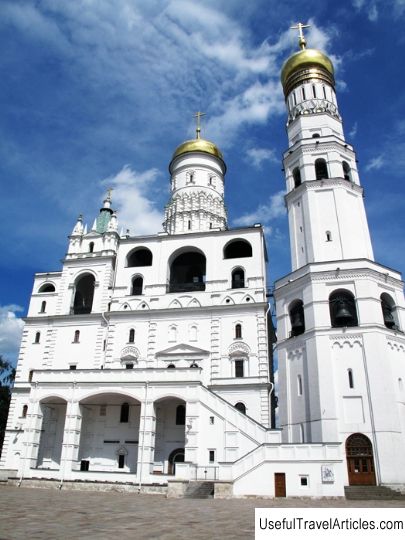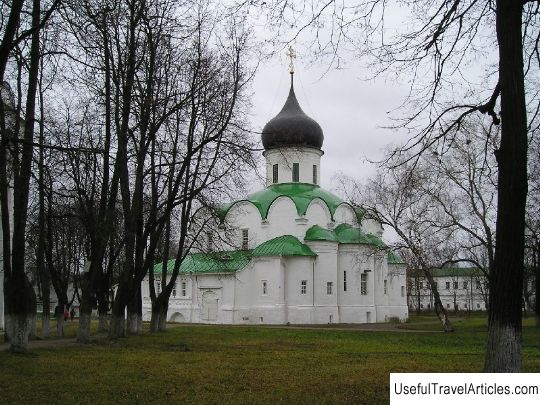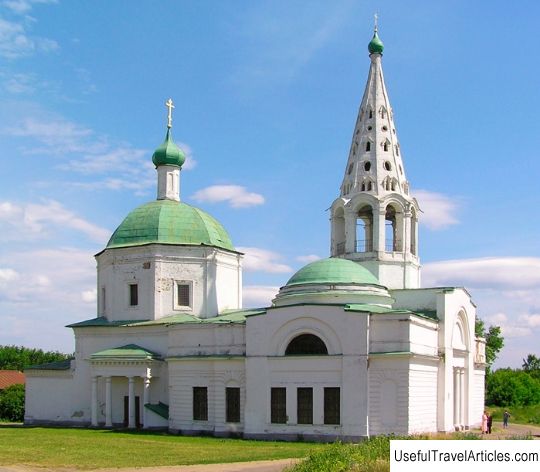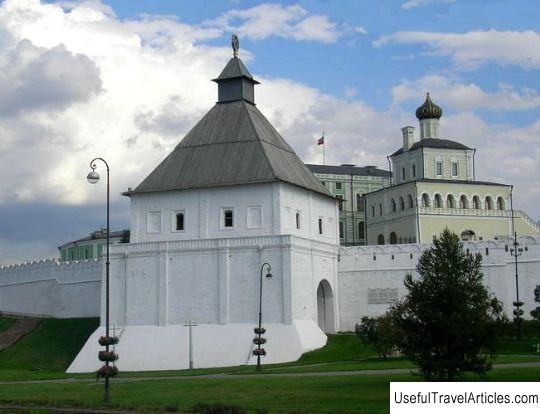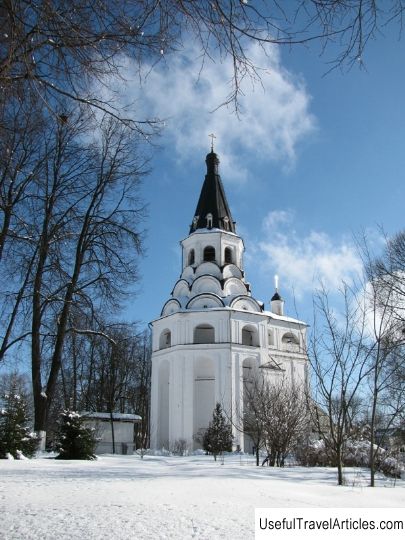Ivan the Great Bell Tower in the Kremlin description and photos - Russia - Moscow: Moscow
Rating: 7,7/10 (6344 votes) 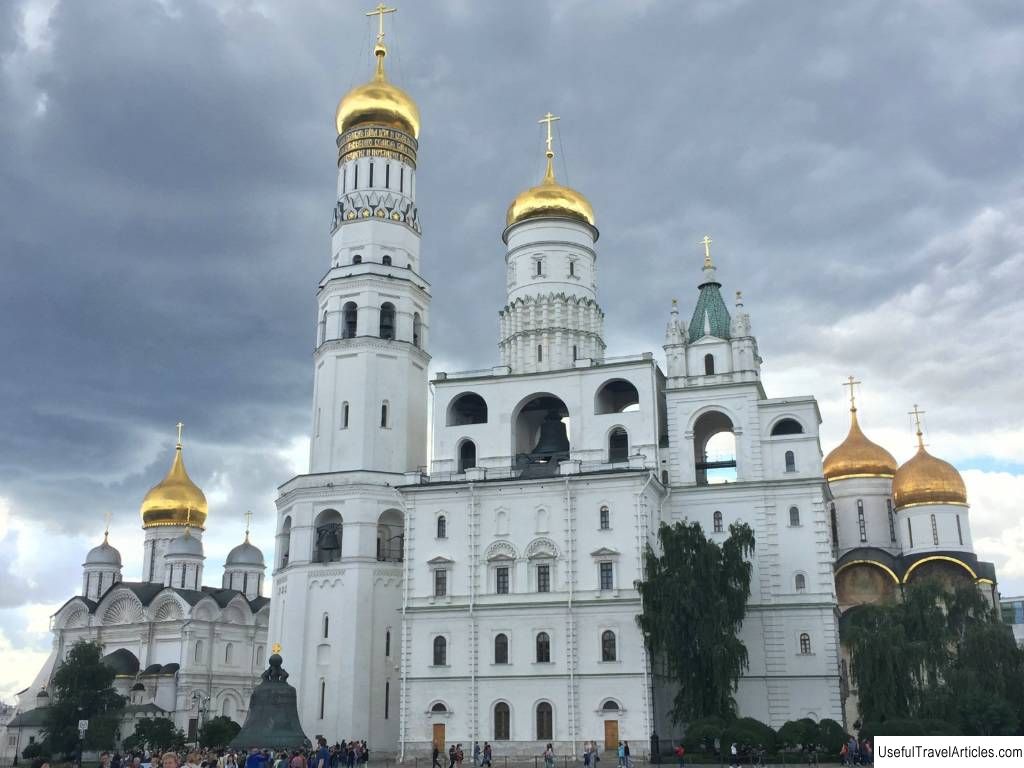
Ivan the Great Bell Tower in the Kremlin description and photos - Russia - Moscow: Moscow. Detailed information about the attraction. Description, photos and a map showing the nearest significant objects. Photo and descriptionThe architectural dominant of the Cathedral Square of the Moscow Kremlin, the Ivan the Great Bell Tower has been rising in the very heart of Moscow for more than five centuries. Church-bell tower was founded in 1505 and today includes the pillar of the bell tower itself, the Assumption belfry and the Filaretov annex. In the Ivan the Great Bell Tower there is a exhibition hall and museum , the exposition of which tells about the history of the emergence and development of the Kremlin architectural complex. How the bell tower was builtThe history of the most beautiful architectural ensemble Moscow Kremlin began back in 1329. The then Moscow prince Ivan Kalita ordered to build a temple on Borovitsky hill, in which, according to the canons of Orthodox Russian architecture, the bells would be located. The church was erected after a successful military campaign in Pskov and consecrated in honor of John Climacus . A theologian from Byzantium lived at the turn of the 6th-7th centuries and was famous for his treatise, which described the steps of virtue that a Christian overcome on the path to spiritual perfection. The church was small, stone and was first built between two Kremlin cathedrals. Its diameter along the outer walls was just over eight meters, and the inner space was about 25 square meters. m. The temple existed for about 170 years and bells were cast for it during the reign of Simeon the Proud . In 1505, the construction of a new temple began. The Italian architect Bon Fryazin was invited to develop the project and its implementation. The old church of John Climacus was dismantled, and in the summer of 1508 Cathedral Square was decorated with a new building. The height of the bell tower, erected in honor of Ivan the Great and crowned with a dome, was 60 meters. The creation of the Italian turned out to be very durable and stable. Legends circulated around the city that the architect deepened the foundation so much that he reached the level of the Moskva River. In reality, the Italian only covered the oak piles with stone, which ensured their safety from decay. The appearance of the bell tower was very reminiscent of the Italian Campanilas - free-standing bell towers at the temples. The diameter of the belfry's foundation was 25 meters, and the walls of the first tier were so impressive, that their thickness reached in places five meters. Formation of the architectural ensemble of the bell tower The rectangular belfry of the Ivan the Great Bell Tower was added in the 40s of the 16th century . Her project belonged to the Italian architect Petrok Maly . Construction work lasted more than ten years, and the building grew not only upward, but also in breadth, reminiscent of the Pskov and Novgorod belfries. The walls were about three meters thick, which guaranteed the safe installation of heavy bells on the windows. Ascended the throne Boris Godunov did not stay away from the architectural transformations in the Moscow Kremlin. The Tsar instructed the architect Fyodor Konu to build on the bell tower and make it even higher and more significant. The sovereign master Fyodor Savelyevich Horse was known for high technique, and the stylistic features of his work demonstrated knowledge of Western architecture and techniques of the masters of the Italian Renaissance. The architect built on the third tier of the bell tower, and the building became the tallest building in Moscow , soaring into the sky by 81 meters. Now the bell tower was called Ivan the Great, and the head and the cross on it were covered with gilding. In the middle of the 17th century, all the bells ceased to fit into the belfry, and it received the fourth tier and the name Assumption. The Filaretov extension was built in 1624. The project was developed and implemented by the architect Bazhen Ogurtsov . The extension was named after the father of Mikhail Romanov, Patriarch Filaret. By the end of the 17th century, the architectural complex of the Ivan the Great Bell Tower became one of the symbols of Moscow and the main Kremlin watchtower. From the upper tier it was possible to see the approaching enemy in advance, because the surroundings were clearly visible for three tens of kilometers. The ringing of bells pouring from the belfry was heard throughout the capital. The bells announced the military successes, the birth of the royal heirs and the royal wedding. It was then that the expression “for the whole of Ivanovskaya” appeared. The Ivanovskaya bell tower for many years remained the tallest building in the capital. All attempts to build something above her have failed. When the architects managed to erect the Menshikov Tower , which rose into the sky three meters higher than the bell tower, lightning destroyed its entire top. Only in 1860 did the bell tower give up its positions - the Cathedral of Christ the Savior that appeared in the capital occupies the first line in the list of the tallest Moscow buildings. Wars and Revolution The Napoleonic invasion brought a lot of destruction to Russian cities, but Moscow suffered more than others. In 1812, the Kremlin was ruled by French soldiers who plundered and burned churches and palaces. A gilded cross was removed from the bell tower of Ivan the Great, which served as a symbol for Muscovites that the city had not been taken. Retreating, the Napoleonic army blew up and burned many buildings, and the bell tower of Ivan the Great was badly damaged among others. Filaretova extension and the Assumption belfry were completely destroyed, and on the bell tower, as a result of the explosion, a deep crack was formed. Fortunately, the fragments of the cross, which Napoleon was going to install in the House of Invalids in Paris, were found near the Assumption Cathedral. The restoration of the bell tower and the restoration of the Philaret annex and the Assumption belfry were entrusted to the state organization that existed in the Russian Empire and was engaged in construction work in Moscow. It was called the Kremlin Building Expedition . The brigade of Russian architects was reinforced with foreign specialists. A Swiss Domenico Gilardi was discharged to Moscow. A new cross was installed at the top of the bell tower, called the Tsar of Glory . The revolutionary events abruptly turned the usual course of history, and in 1918 the territory of the Moscow Kremlin was turned into hostel , where more than two thousand people spent the night. The bells on the belfry of Ivan the Great were silent for a long time. Their tongues were shackled to their bodies so that even by accident the bells could not ring. Muscovites and guests of the city could hear them again only on the day of Holy Christ's Sunday in 1992. The Bells of Ivan the Great The Ivan the Great Bell Tower occupies a special place among the sights of the Moscow Kremlin. All twenty of its bells have a long history, and their singing accompanies divine services in the cathedrals of the Kremlin and the divorce of guards. - The largest in the bell tower is Assumption bell . It weighs over 65 tons. For the first time the Assumption bell was cast in 1760, but was badly damaged by the retreat of the French in 1812. After the victory in the Patriotic War, Russian foundry craftsmen transformed the Assumption bell. His body is adorned with high reliefs depicting members of the imperial family. Uspensky is the second largest after the Tsar Bell, which is located in Trinity-Sergiev Posad, and the best in sound and tone. - Ivan the Great's second in weight and size bell is called Howler , or Reut. It is older than Uspensky - it was cast by Andrey Chokhov in 1622 by order of Mikhail Fedorovich. The howler monkey weighs over 32 tons. During the retreat of the French army, the bell was damaged, but only slightly. The restoration made it possible to preserve its ringing. The sad story with Howler happened during the coronation of Emperor Alexander II. The giant that fell from the crossbar struck five floors of the bell tower and killed several people. - In the 18th century, a Lenten Bell cast by Ivan Motorin . The bell weighs more than 13 tons, and its body is decorated with baroque ornaments. - The oldest of all Ivan the Great's bells is named Bear . He received it for the low timbre and special power of his voice. The bear was first cast in 1501 by master Ivan Alekseev . In the second half of the 18th century, the bell was poured. Its weight today is more than seven tons. - The Swan weighs about the same, the sound of which resembles the cry of a beautiful bird. The bell was made in the 16th century. - Another famous bell of the Moscow Kremlin was made for the St. Sophia Cathedral in Novgorod under Ivan the Terrible, and later recast in Moscow. It is called Novgorod and the apostles are depicted on it. - The ornament of the bell, cast in 1679 by the Leontyevs brothers, resembles an ancient Russian type of jewelry technique called filigree. The bell weighs Wide about five tons. - The Rostov bell is dedicated to the reign of Ivan V, Peter I and Tsarina Sophia. It was made in 1687 for the Belogostitskaya monastery in Rostov the Great. He ended up in Moscow later. - On the second tier there are bells made in the period from the middle of the 16th to the end of the 17th centuries. The oldest of them is called Nemchin . It was brought from Europe during the Livonian War. In the 19th century, the writer A. Malinovsky this is how he spoke about the ringing of the Ivanovskaya bell tower: “When all the bells are rung, everything close to their sounds comes to such a tremor that it seems as if the earth is trembling.” Museum and Exhibition Hall Ivan the Great In 2008, was opened in the main Kremlin bell tower museum exposition , which tells about the history of the Kremlin. The collection of the museum presents to visitors nine centuries, during which the Moscow Kremlin was built, developed, changed and rebuilt after fires and wars. Fragments of the Kremlin buildings, which are described in the chronicles, have been preserved on the stands of the museum. The exposition allows you to imagine how the temples and chambers that are now lost looked. The opportunity to climb the bell tower is of considerable interest to museum visitors. A spiral staircase with 137 steps leads to the observation deck . In the exhibition hall of the Ivan the Great Bell Tower, organized in the Assumption Belfry, various events are held within the framework of cultural and educational projects of the Moscow Kremlin museums. In the belfry, you can get acquainted with exhibits of both domestic and foreign exhibitions.          We also recommend reading Suan Pakkad Palace Museum description and photos - Thailand: Bangkok Topic: Ivan the Great Bell Tower in the Kremlin description and photos - Russia - Moscow: Moscow. |
